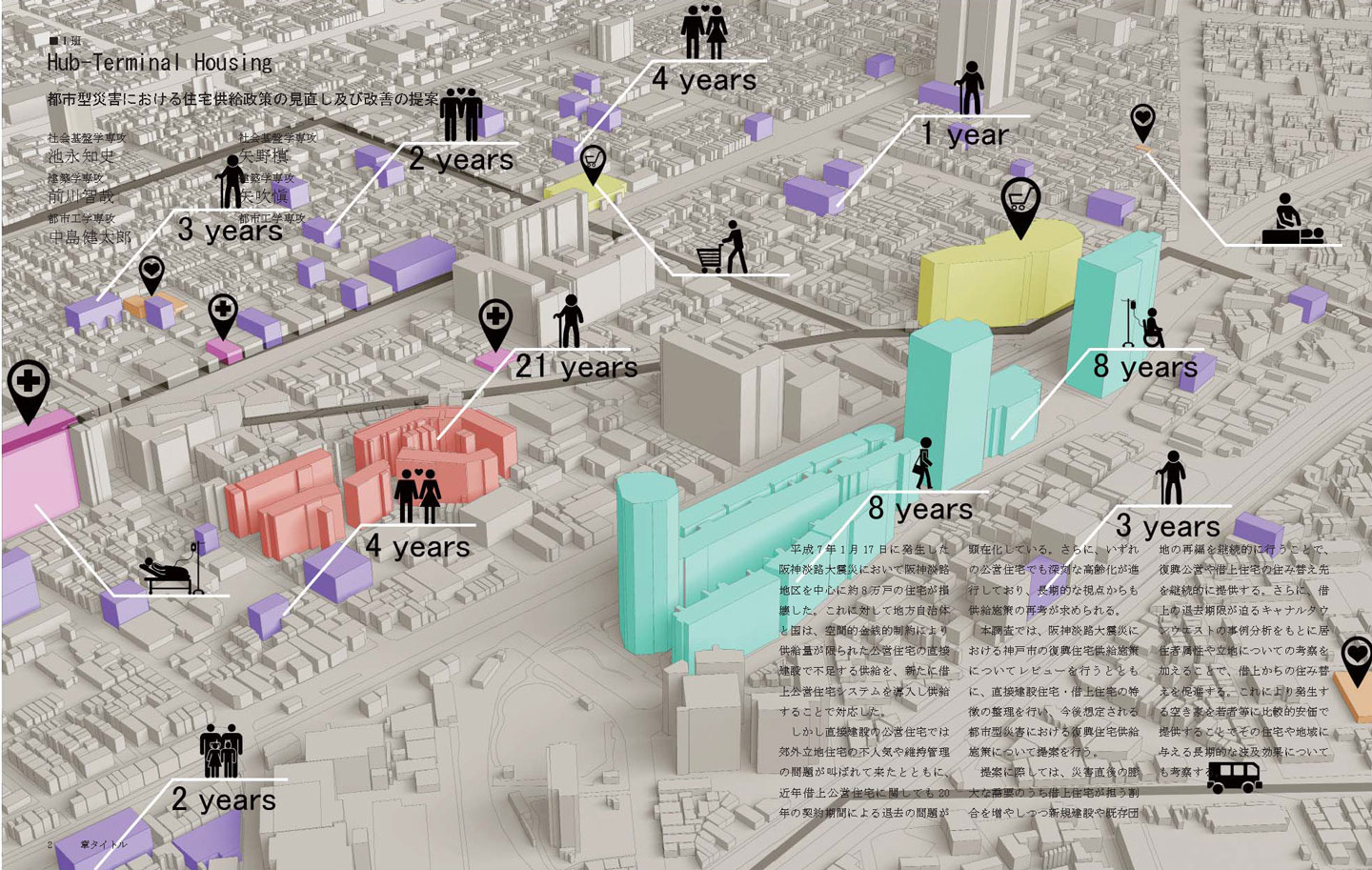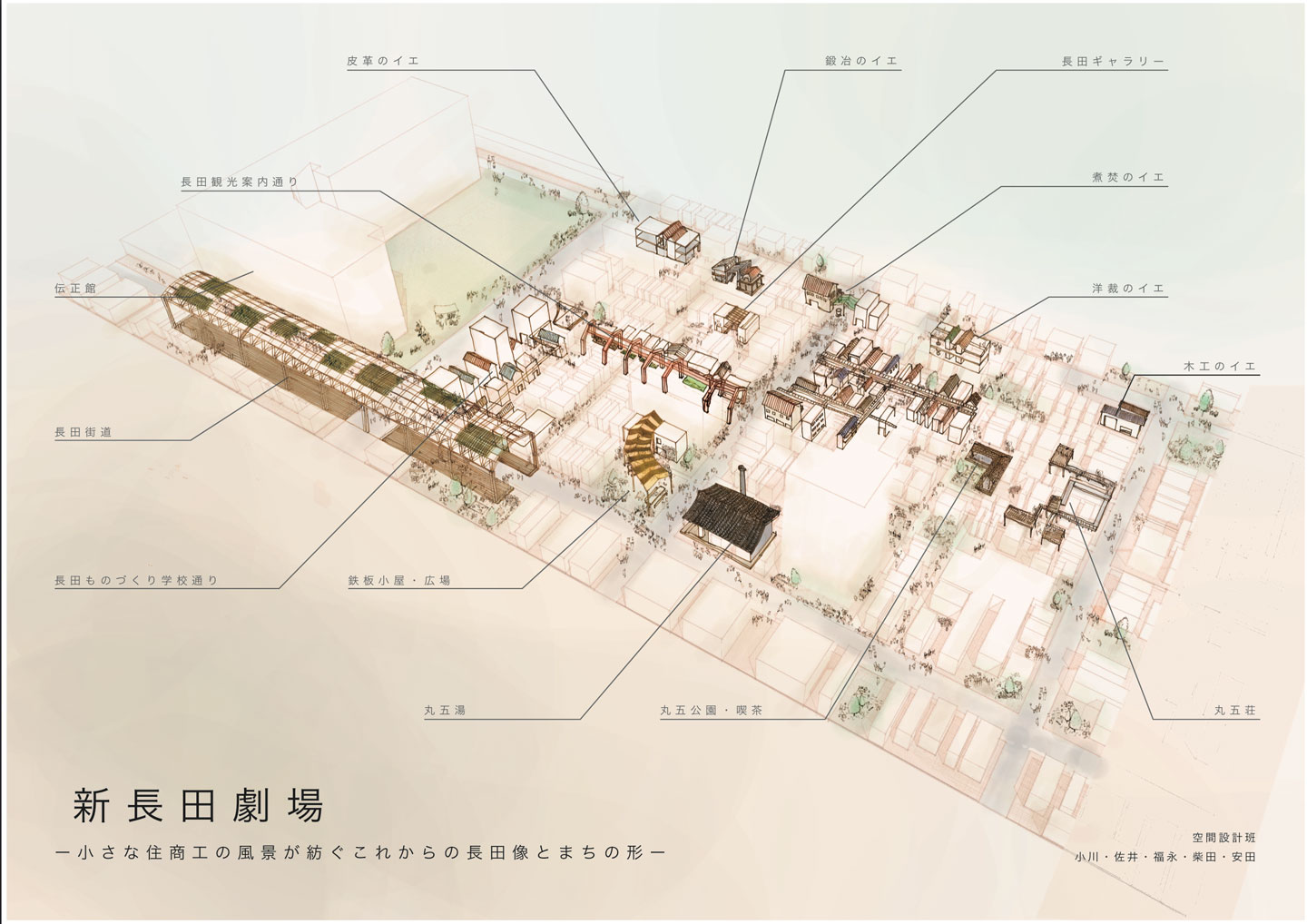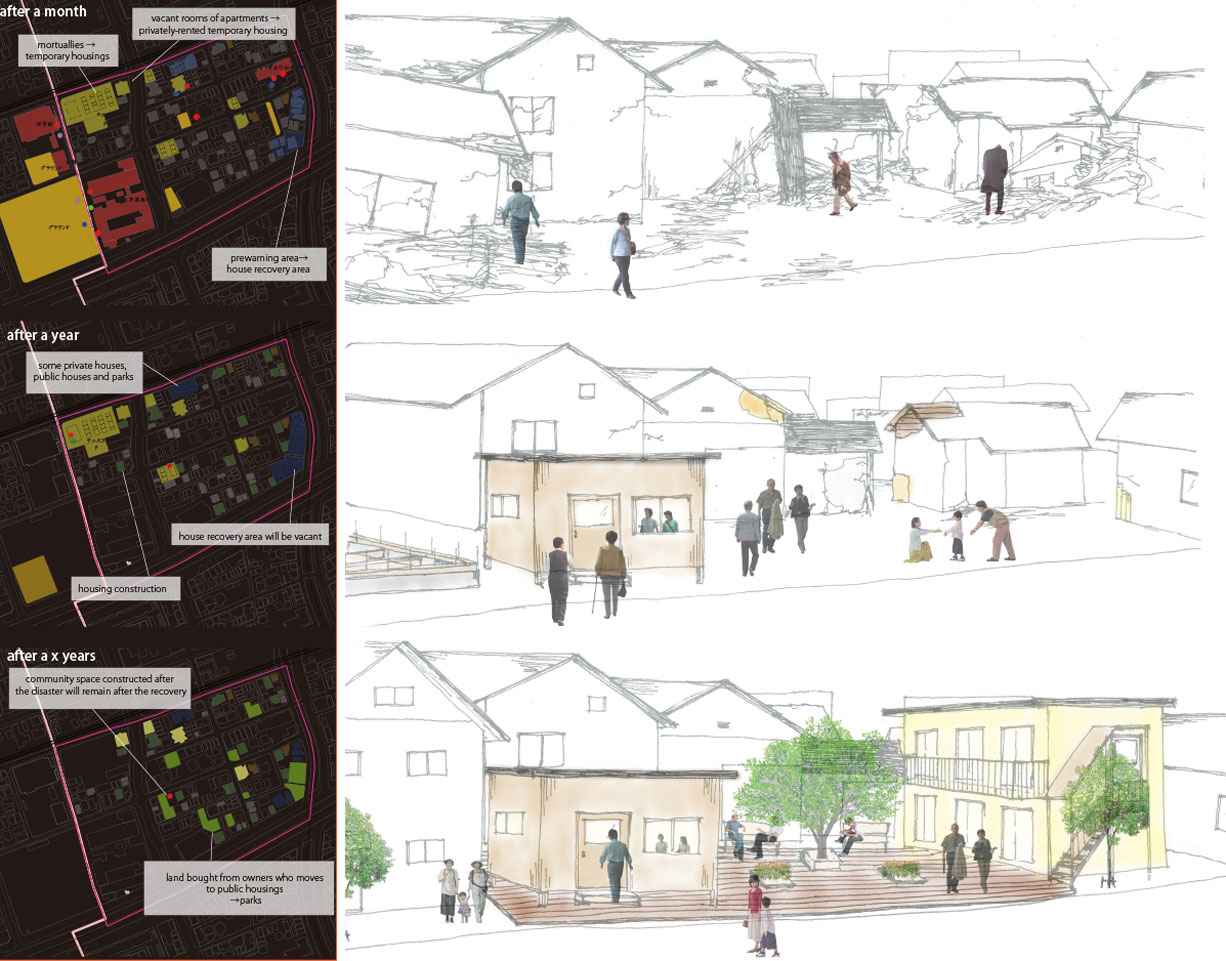2014年度夏学期 復興デザインスタジオ
阪神淡路大震災の復興事業をリ・デザインする
課題主旨
これからの復興デザインの在り方を学ぶために、講義、現地調査、関係者のヒアリングなどを通じて過去の実例を理解する。具体的には、被災前/災害時/復興事業という三時点における空間の変容過程を把握し、復興事業を評価する。現状の利用実態や周辺の貢献度合いなどのほか、どのような想定ができていたのか、次の震災の事前対応となっているのかどうかも重要な視点であろう。他の要素も含めて、どのような評価がなされるべきか、その方法論も検討する。 時系列や平面の地図だけではなく、特に、立体の模型も駆使して、空間を把握する。当時の風景から被災を「想定」すること(想定できない予知の理解も含めて)、そこからの復興計画において配慮すべきことの習得をめざす。 そのような理解をふまえて、神戸の現状に対してレジリエンスを高める方向性を提示する。
Purpose of the StudioThe purpose of this studio is to understand and evaluate the transformation of spaces /before/then/after/ Han Shin Awaji Earthquake Disaster in 1995. After twenty years, how we can evaluate the recovery, is the question underlying the theme of the studio. During the studio, students are expected to analyze and evaluate recovery process using different scales, from urban engineering scale to architecture scale. It is also expected to develop it as political or designing proposal for contemporary Han Shin Awaji.
チーム1:Hub-Terminal Housing -都市型災害における住宅供給政策の見直し及び改善の提案
震災後、市街地の用地不足のため、行政は借上げ公営住宅制度(既存の民間住宅を借り上げて公営住宅としての活用を可能にする背戸)制度を導入した。この制度によって、初期投資をおさえながら市街地でのより多くの住宅確保が可能となった。その一方で、契約期間である20年が終了すると退去を余儀なくされるが、特に低所得者や高齢者などにとっては大きな負担となる。20年の契約期間終了が目前となった今、転居が困難となった居住者の存在が大きな課題となっている。チーム1はこの問題を解決することを目指し提案を行った。本提案の特徴は、借上公営住宅については一時的な住宅(ハブ)として位置づけ、終の棲家になりうる復興公営住宅やその後も継続的に新設していく第二公営住宅(ターミナル)と明示的に区別している点にある。まず、初動段階の復興公営住宅と借上公営住宅による住宅供給については、先んじて供給が可能である借上公営住宅への入居を進める一方で、復興公営住宅の供給が始まり次第、入居を優先すべきと判断される被災者を中心にまず復興公営住宅への入居、次に借上公営住宅への入居を進める。継続的に供給を行う第二公営住宅については、主に借上公営住宅からの移転先としての役割だけでなく、郊外の利便性の低い公営住宅からの住み替え先としての役割も果たす。第二公営住宅への住み替えの促進により、借上公営住宅には返還時期が近づくにつれて空室が増加すると考えられるが、短期的居住を受容できるような属性の人々向けに比較的安価に提供することで学生など元気な人々を呼び込み、借上公営住宅に活力を導入するだけでなく、借上公営住宅から民間賃貸住宅へと移行していく過程についても滑らかに移行できることが期待される。
Hub-Terminal Housing, Team1Team 1 focused on providing system of public restoration housings. Because of lack of sites inside the city for new public restoration housing constructions, government revised the law of public housings to allow municipally subsidized rental housing system. It was efficient to provide houses inside the city with low initial investment. However, the contract period which is 20 years of the rental housings will be over. It is becoming a big problem especially for low income elder people, who are difficult to move out and live by their own. To conclude this problem, this team proposed a new providing system of public restoration housings. They proposed to provide housings in 2 different phases. The first one is ‘Hub Housing’ which is municipally subsidized housings, and the second one is ‘Terminal Housing’ which is provided 4-5 years after the disaster. The dwellers will move from Hub Housing to Terminal Housing when they are able to move such as when they get married or when they are retired etc. So that after 20 years, Terminal Housing would be turn back to private housings.

チーム2:新長田劇場
新長田地区は第二次世界大戦で被災せず、そのため戦災復興が行われずに木造密集地域が広がっていた。そんな場所を阪神淡路大震災が襲い、非常に広大な地域が火事に飲み込めれ失われてしまった。そして、神戸の副都心となる事を想定した復興再開発事業が大規模に行われ、地域を分断してしまった。現在では空きテナントや管理組運営において問題を生み出しており、20年経った今でも復興計画の影響が強く残っている。この地区で、20年という時間軸を通してこれまで起きてきた事を振り返り評価し、この先の新長田の将来像を考えることが必要だと考えた。新長田2014 年から再開発地域が老朽化する2064 年までを時間のスケールとして想定し、新長田のリ・デザインがに行われていくのか、それぞれの部分でどのような風景が展開されるのか、そしてそこで暮らす人びとの人生を、「新長田劇場」として提案した。最初は町工場や職人によるものづくりの活動が行われる。その活動を続けるうちに活動の規模は大きくなっていき、宿舎や職人のための寮が作られていく。住み込みで働く職人志望の人びとが集まり、新長田にものづくりの風土が根付く。そして町中で技術を学べる「まちなか大学」や「観光案内所」が生まれる。こうした小さな操作の重なりから、人々の大きな重なり(働く憩う住むの共有、人々の新たなつながり)を創出しているプロセスを提案した。
Shinn-Nagata Theater', Team 2Team 2 focused on regeneration of retail complexes in Shin-Nagata area. Shin-Nagata area is an old high density wooden housing area, where most of the area was burnt by the fire at Han Shin Awaji Earthquake. After the disaster, there were redevelopment projects done by Kobe City which constructed 44 high-rise and mid-rise buildings, and the project divided the area into redeveloped and underdevelopped area. In addition, the area became declined especially after 2000, and there became many vacant shops. The team tried to solve these problems by designing a system and spaces to call in especially young people from outside the city. They also proposed activities occurring in the area. The activities are small at the beginning such as manufacturing by local artisans but they gradually grow to be a college for example after 50 years.

チーム3:復興過程における空間の時限的利用
空間の利用には、本来の日常的な使われ方と、場所の特質を発揮した非常時の使われ方がある。例えば非常時、学校はその中心性や広さを発揮し避難所や炊き出しスペースとなり、公園はその広さや自由度の高さから瓦礫置き場や仮設住宅地として利用される。このような「空間の時限的利用」は、災害後の街の変化過程において欠かせないものである。特に、阪神・淡路大震災においては、既存市街地の土地だけでは非常用途の需要が満たせず、郊外に仮設住宅用地など多くの土地を求めた。その結果、不便に堪えかね身寄りを頼って他市町村・都道府県など別の土地に移住してしまう被災者が続出し、最終的には既存市街地の衰退を招くこととなった。土地の本来の使われ方をできるだけ長期間制限しないため、そして街の衰退を防ぐためにも、災害からの復興は既存市街地でコンパクトに進めることが大切なのではないかと考えた。復興過程における「空間の時限的利用」の必要性は、用途・量ともに時間経過に応じて変化していく。例えば空地は時間経過と必要に応じて瓦礫置き場、仮設住宅用地、公園用地と用途を変化させることで復興に寄与できるというように、時間経過と必要に応じて土地利用をダイナミックに変化させ、一つの土地で複数の時限的利用をこなすようにすることで、土地の持つポテンシャルを活かしつつ、郊外へ拡大せずに復興を成し遂げることができると考え提案を行った。
'Time Limited Usage of Space, During the Recovery Process', Team 3Team 3 focused on time limited usage of spaces, during the recovery process. After the disaster, lands in different phases and for different purposes are needed. For example, temporary evacuation shelters were needed soon after the disaster and be reduced to half in a week. Construction of temporary housings were started a week after the disaster and it took 5 years to close all of them (see Fig.4). Focusing on locations of these facilities, many temporary evacuation shelters were using schools inside the city so that victims can be stay in the area they used to live. On the other hand, temporary housings were located both inside and outside the city to obtain larger public land to construct many houses at once, so people had to move out from their community. The team proposed followings, 1) construct a system for re-build and renovation of damaged houses, 2) make an agreement about the use of private lands after the disaster, 3) build assistance program for reinforcement of existing houses. These would be reducing the demand of temporary housings and help victims to live in their community continuously.
